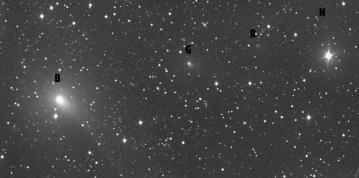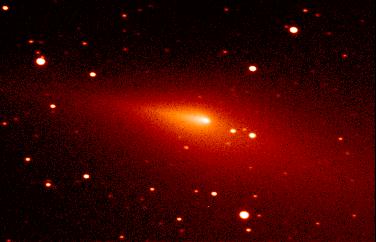Periodic comet 73P/Schwassmann-Wachmann 3 has broken into more than 30 different pieces as it approaches the sun. This comet was discovered on 1930 May 2 by Arnold Schwassmann and Arno Wachmann at the Hamburg (Germany) observatory. It was the third periodic comet discovered by this pair and the 73rd comet to be recognized as periodic.

Because of poor observing conditions, the comet was not recovered during its next return to perihelion in 1935-36. As a result, the comet’s preliminary orbit was rough and the comet’s close passes by Jupiter in 1953 October (0.9 AU) and 1965 November (0.25 AU) further degraded the orbital predictions. One Astronomical Unit (AU) is about 93 million miles. The comet was re-discovered on Aug. 13, 1979, missed during the next return to perihelion in 1985-86 — again because of poor observing conditions - and then observed during its returns in 1990, 1995-96, 2000-2001, and the current 2005-2006 return. In late 1995, the comet began to breakup into various fragments. The main comet (fragment C) was seen to give rise to two new fragments, A and B.
In 2001, the main comet (fragment C) was observed along with the old fragment B and a new fragment E.
During the 2006 return to perihelion, which for the main fragment C takes place on 2006 June 6 (just inside the Earth’s orbit), the comet began to fragment into more than 30 additional pieces. All of the observed fragments in 2006 will pass relatively close to the Earth during the interval May 12 through May 28 but none will pass closer than 5.5 million miles. These passages of the fragments past the Earth offer astronomers an excellent opportunity to examine the cometary breakup process and hopefully these observations will shed some light on just why some comets disrupt. Apparently some comets have very weak internal structures and perhaps rapid rotation or the pressure of vaporizing interior ices, as the comet approaches the warming sun, causes these breakup events.
In addition to ongoing ground-based visual observations, the Hubble Space Telescope and the Spitzer infrared space telescope are continuing to observe the comet and the Arecibo and Goldstone planetary radars will begin observations on April 30, 2006.
For predictions of where on the night sky these fragments will appear (i.e., ephemeris predictions), go to: https://ssd.jpl.nasa.gov/horizons.cgi and request information for comet 73P. The main comet, which is also the brightest, is fragment C.


